The US y/y inflation metrics will climb sharply from the last round of October readings through Q1 of 2020, thanks to a shift from easy to hard comparisons attributable to the big commodity price sell-off last year at this time. The trade price measures have been depressed by new tariffs, but tariffs should lift domestic prices into the new year.
Booming US oil production should cap energy price gains into 2020, though a firming in global growth should provide support. Most inflation measures are expected to fluctuate around the Fed’s 2% objective after the climb into Q1, leaving more balanced risks for Fed policy as the policy pause extends into the new year.
A steep y/y inflation rise should be seen for for headline CPI, where last week’s October rise to 1.8% should have extended to the 2.5% area by February, while the core y/y price gains remain close to October’s 2.3%.
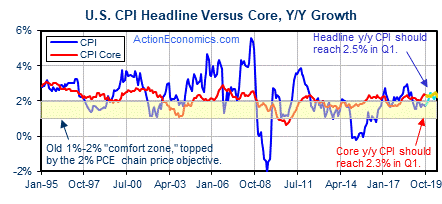
The Fed prefers to track the PCE chain price figures, where annual y/y gains have underperformed CPI increases since 2010. The September report left us with y/y gains of 1.3% for the headline and 1.7% for the core. A rise to 2.0% by February is anticipated for the headline and by March for the core, with balanced risk for inflation from there. The Fed is unlikely to initiate a tightening cycle until inflation is well above 2%, but will probably also not resume an easing cycle unless we see a new big downdraft for prices or a slowdown in the economy.
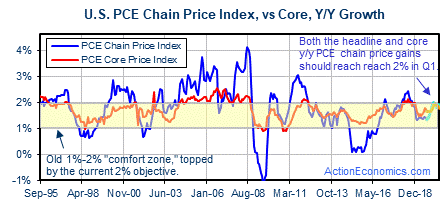
For the October trade price report, drops have been identified of -3.0% for import prices and -2.2% for export prices, as tariffs depress the pre-tax trade price measures. This is because producers, to some degree, absorb the cost of new tariffs by lowering their prices so that established retail price points and market share can be maintained. Producers may later re-source inputs, trim product quality, or raise retail prices, but these effects take time. To the extent that retail prices are raised the tariffs boost the domestic indexes, but the trade price measures stay depressed.
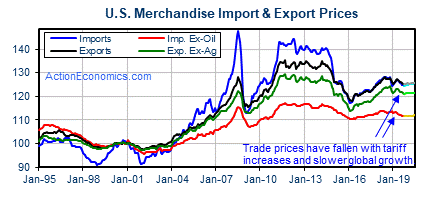
New tariffs also raise the value of the Dollar, which in turn depresses trade prices. This leaves the offsetting tariff impact on the current account deficit that prompts the effect (counter-intuitive to some) that higher tariffs don’t cause the aggregate trade deficit to change as long as the capital account surplus is unchanged, even though country-specific tariffs change bilateral deficits like we’re seeing now between the US and China.
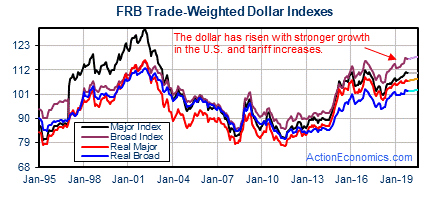
This rise in the Dollar with tariffs has capped the upward pressure on domestic inflation that might be expected from the tariff impact on specific items like washing machines, as tariff-exposed products see price gains while other products face offsetting downward pressure. A modest lift to prices that dissipates through the year is forecasted into early 2020 from tariffs, and this effect may get capped if a “phase one” deal actually reverses some tariffs.
Inflation in the advanced economies moderated with oil prices in 2019 after a petroleum-led bounce in 2017-18. An up-tilt in inflation rates is seen for the advanced economies into 2020.
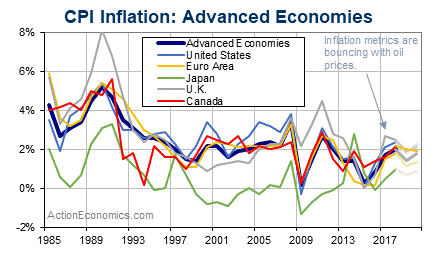
For inflation expectations, pricing from the TIPS market suggests that expectations for inflation have generally fallen modestly through 2019, though the trend since October has been upward. The recent readings in the 1.5%-1.6% area are in line with recent lean inflation figures, but low relative to the y/y gains seen by Q1 2020.
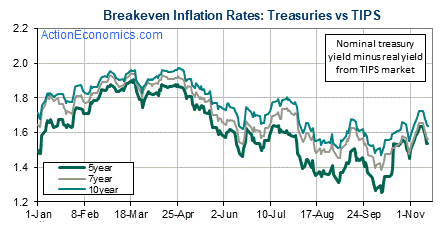
Overall, the US y/y inflation metrics, as initially stated, are expected to climb sharply over the coming four months thanks to a shift from easy to hard comparisons attributable to the big commodity price sell-off last year at this time. The inflation next year should sit near the Fed’s 2% objective, which should leave more balanced risks for rates as the Fed’s policy pause carries on.
Click here to access the HotForex Economic Calendar
Andria Pichidi
Market Analyst
HotForex
Disclaimer: This material is provided as a general marketing communication for information purposes only and does not constitute an independent investment research. Nothing in this communication contains, or should be considered as containing, an investment advice or an investment recommendation or a solicitation for the purpose of buying or selling of any financial instrument. All information provided is gathered from reputable sources and any information containing an indication of past performance is not a guarantee or reliable indicator of future performance. Users acknowledge that any investment in Leveraged Products is characterized by a certain degree of uncertainty and that any investment of this nature involves a high level of risk for which the users are solely responsible and liable. We assume no liability for any loss arising from any investment made based on the information provided in this communication. This communication must not be reproduced or further distributed without our prior written permission.



















